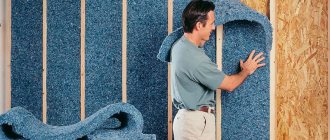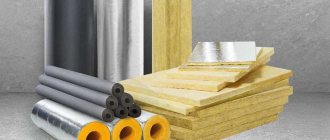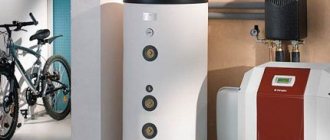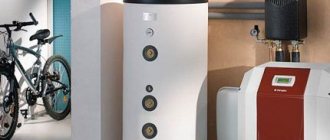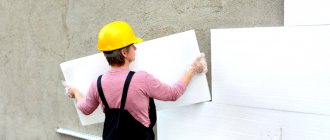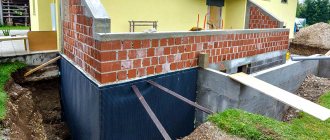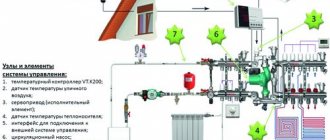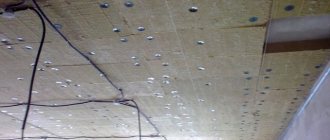Today we will tell you about bulk insulation, which is available in eight different types. The variety is simply impressive, as they are made from paper, stone, resin, polymers and even clay. Each material has its own strengths and weaknesses, although there are also those that there is nothing to praise for, even if one would like to. All bulk insulation can be installed using two methods: manually or using a compressor. Such materials are good because they fill all the cracks and voids. And negative qualities include shrinkage, which is inherent in all insulation materials from this cohort.
Advantages of bulk insulation
Insulating a house is a very important step in completing construction. The main objective of this procedure is to significantly reduce the level of heat loss, which will allow you to save on insulation; you just need to choose the right thermal insulation material. In addition to the low thermal conductivity of bulk materials, which determines their particular popularity, they have other undeniable advantages:
- have good resistance to temperature fluctuations;
- have a sufficiently low weight, creating a minimal load on the walls or ceiling;
- They are environmentally friendly and fireproof material;
- retain heat well in rooms;
- are durable.
Working with bulk materials is quite simple; their installation does not require special skills or expensive tools. Delivery of bulk insulation in bags does not require special equipment or a manipulator. You can bring such high-quality modern thermal insulation in a regular car trailer or even in the trunk. When laid, backfill insulation easily fills any space without leaving voids or cracks; it is only important to select the required fraction.
To sum up
Bulk mineral insulation has become an integral part of modern construction. The materials are relatively new, but they are quickly gaining their share of the building materials market. Such thermal insulators undoubtedly have advantages; no one is trying to dispute them. Some people are only stopped by the novelty of the materials. Our people don’t particularly like new products, especially when it comes to construction for many years, in which they invest a lot of money. But all new products become proven materials, and very soon this will happen with bulk insulation.
Types of bulk insulation
Classification of insulating materials is carried out according to several criteria:
- Nature (natural or synthetic).
- Structure (grain or fibrous).
- Installation methods.
Important! As a rule, loose insulation is sold in bags.
Expanded clay
The usual form of this material is round or oval granules. Granules or other shaped material are porous and very light (some types can float on the surface of the water). Expanded clay is formed by firing light alloy clay. It is absolutely non-flammable, safe, and environmentally friendly in its composition.
The material can be in three forms:
- sand with grain size from 0.14 to 5 mm. It is used as a filler for lightweight concrete and for floor insulation;
- Expanded expanded clay crushed stone is granules with a fraction of 5–40 mm. The best option for thermal insulation of foundations and floors of residential premises;
- expanded clay gravel. Round granules 5–40 mm with a fused surface, absolutely resistant to fire. They have closed pores inside, which gives them excellent frost resistance. This gravel is recommended for insulating attic floors: the material is lightweight and has low thermal conductivity.
The labeling of a material must include the size of its fraction:
- 5–10 mm – floors and roofs;
- 10–20 mm – baths and saunas, able to maintain temperature and humidity in the room for some time;
- more than 20 mm - for foundations and basements.
Vermiculite
This is a mica-based layered material. No chemical additives or impurities are used in the manufacturing process. It is an excellent option for insulating loggias and rooms. Used as an energy-saving cladding for housing inside and outside. For floors and walls, a layer of at least 10 cm is recommended, for the roof - at least 5 cm. Backfilling with this material 5 cm thick reduces heat loss by 75%, 10 cm - 92%.
Material Features:
- high breathability of insulation - the material is porous - which allows the walls to “breathe”, ideal for natural circulation, air renewal and ensuring a microclimate in the room;
- environmentally friendly, without toxic substances;
- non-flammable, fire-resistant, belongs to the G1 flammability group;
- fungi, mold, rodents, insects are not afraid of such isolation;
- special skills or experience, special tools are not needed to fill it. The layer of material is simply poured back and compacted. No additional fasteners are needed;
- service life - more than 50 years.
For walls, a vermiculite backfill thickness of 10 cm is sufficient, for attics, roofs, and interfloor ceilings – 5 cm. When laying, it is advisable to use a vapor barrier film - this will additionally protect the insulation from moisture.
Sawdust and sand
These are traditional heat preservation materials that are used in attics and basements and have been used for centuries. Disadvantages: they are poorly insulated from moisture, pests can grow in them. Sawdust is flammable and susceptible to mold and mildew. It is still recommended to use more modern materials.
For insulation, they use not ordinary sand, but perlite. It is light weight, less hygroscopic, and its characteristics resemble mineral wool. Due to its low bulk density, it does not create a load on the walls and does not burst them.
Ecowool or cellulose
The components of this insulation are ecowool (7%), shredded paper (81%), antiseptics (12%) and fire retardants (7%). The material is non-flammable and does not rot thanks to special impregnations. It has been used in the world for more than 80 years; it has been known in the CIS for the last decade.
This material uses boric acid as an antiseptic and borax as a fire retardant. These substances are environmentally friendly.
The material is quite practical: the fibers fill small voids well, so it is recommended for complex structures.
Aerated concrete crumbs (backfill)
Aerated concrete chips are a mixture of porous crushed stone and sand obtained after crushing aerated concrete. Unevenness of fractions up to 30 mm, irregular shapes of particles form a layer that does not lose its given shape. It is used as bulk insulation, additional bedding for sound insulation in building structures (walls, ceilings). It is in demand as insulation for pitched roofs with a slight angle of inclination. Does not disrupt natural circulation, providing optimal humidity and gas exchange. Backfill aerated concrete chips are used instead of expanded clay in lightweight concrete when pouring the foundation. In this case, aerated concrete crushed stone insulates the foundation, due to its low thermal conductivity, and also contributes to its anti-swelling. Inexpensive drainage and insulation for road surfaces. The disadvantage is the dusting of fine fractions during backfilling.
Foam glass (fill-in insulation)
Foam glass. As a fill-in insulation, it comes in several types and this is due to different technologies for its production. This:
- filing of foam glass slabs;
- foam glass crushed stone obtained by foaming the mass and rapid cooling. This leads to destruction; additional mechanical crushing produces crushed stone without an outer fused layer;
- granulated foam glass, which is widely used in the construction market, both as an independent backfill and as the basis for heat-insulating plasters.
Types of backfill thermal insulation
Hundreds of years ago, in the construction of wooden houses from timber or logs, the very first fill-in insulation was used - sawdust. Like modern analogues, they were quite good in terms of thermal conductivity, but they shrink or lose their properties when wet. Today's materials are more advanced in many ways. The most popular of them are discussed in detail below.
Insulation based on clay. It is used as an independent heat insulator for residential or industrial buildings, or in combination with concrete (expanded clay concrete is obtained). Today it is obtained by burning clay shale.
Production technology varies depending on the required size of the final granules.
By studying the labeling of the fill-in insulation, you can understand what size granules of the material are and for what areas of the house it is suitable. For example, expanded clay sand is used as a heat insulator for floors or acts as a component of concrete cladding. Granules with a diameter of 5-10 mm are suitable for pitched and flat roofs, floors, and attics; larger than 15 mm - for insulating a basement or foundation.
Expanded clay inevitably settles as it is used, so during initial installation it must be compacted strongly to minimize shrinkage. It is recommended to insulate walls with this material only in regions where the temperature in winter does not drop below −20 degrees.
The insulation is made from silicate volcanic rocks using the same technology as expanded clay. When heated to 1000-1200 degrees, moisture evaporates from the surface of the stones, leaving air inside them. The result is white or gray granules with a diameter of 1 to 10 mm. The density of perlite ranges from 75 to 150 kg/m3, and because of its color it is also called “glass insulation.”
Minimum size granules (1-2 mm) form perlite sand, used in the following areas:
- insulation of premises of residential buildings;
- production of acoustic materials;
- production of insulating plaster;
- creation of fire-resistant concrete.
Granules filled with air weigh less than expanded clay, so they are suitable for thermal insulation of walls. In addition, the material will resemble mineral wool, since in addition to preserving heat, it will prevent the penetration of extraneous noise into the room.
Expanded material made of hydrated mica, increased in volume by 15-20 times through heat treatment. It has increased fire-resistant properties, due to which it is used when installing chimneys. Ideal for floors and walls.
A thin layer of vermiculite 5 cm thick will retain up to 70% of the heat of the room. This is enough to insulate the roof. For walls, floors and foundations, it is recommended to make twice as much material.
The density of vermiculite is lower than that of expanded clay or perlite - the highest volumetric mass is 100 kg/m3. This fill-in insulation is supplied in bags of a certain volume, and is used in almost all rooms of a residential building.
The advantages of vermiculite include:
- low thermal conductivity coefficient (0.04-0.06), comparable to foam plastic and mineral wool;
- no possibility of voids and seams;
- high melting point (1400 degrees);
- absence of toxic materials;
- biological resistance (prevents mold, mildew, is not of interest to rodents);
- good sound insulation;
- the lightness of the material, allowing it to be used in frame houses, on supporting systems or foundations;
- ease of insulation work and time saving.
Ecowool.
A relatively new material that appeared on the market only 10 years ago. Made from recycled paper, fire retardants (substances that prevent fire), and antiseptics. Safe for humans, resistant to rotting, and does not spread fire. It is most often used for thermal insulation of walls, attics or roofs of complex construction.
Features of raw materials
Having familiarized ourselves with the main types of bulk insulation, we can summarize that it is always secondary raw materials. It is produced by processing various wastes ranging from cellulose to minerals. Bulk heat insulators in most cases are pure environmental raw materials. Their common drawback is the need to create a facing partition: the insulation is poured between it and the main ceiling, for example, a wall.
conclusions
In the article we talked about the key points for using stone wool aspiration. Let's summarize what has been said. So, the advantages of mineral wool crumbs:
Disadvantages of insulation obtained from stone wool production waste:
We recommend a topic that describes in detail the use of mineral wool aspiration - Decagon, or the path from the sphere to the coaxial yurt.
Source
Backfilling methods
The process of filling any insulation is the same: the material is poured into the cavity and compacted. It is recommended that the issue of insulation be addressed immediately when designing a house. If there are no internal cavities for filling in insulation, layers are made using PVC panels or plasterboard.
A good option is when the insulation is poured between facing and ordinary bricks, between internal and external masonry. There may be ribs inside so that it is well distributed. Thanks to loose thermal insulation, the walls do not need to be made thick, which saves costs. There are ready-made concrete products on sale - slabs, inside of which there are already cavities filled with expanded clay; they retain heat 50% better than ordinary ones.
Options
For floors, these methods of insulation with bulk components are used. The first option is fill-in (or loose) insulation on the joists. Joists are made on the floor on posts, skull blocks are nailed, then flooring is made of boards. A vapor barrier is placed on the flooring and expanded clay is poured. Further, if necessary, the next layer of thermal insulation, on it - screed, rough wood flooring.
The second option is an embankment on top of a concrete slab. An option for low-quality housing - Khrushchev, for example - when it is possible to raise the floor level. The floor covering is removed, waterproofing is laid, expanded clay is poured onto it in a layer of 5 - 10 cm. Then you can put a mesh for reinforcement, and a rough screed is made on it - the basis of the finishing floor covering. A vapor barrier is laid on top of the expanded clay cushion, and another layer of insulation is placed on top of it.
Insulation of walls and ceilings
To keep the house warm and comfortable, it is necessary to insulate the external walls. For this purpose, foam glass, a granulated environmentally friendly material obtained from raw fractions by foaming, can be used. This wall insulation is chemically resistant and can form the basis of heat-insulating plaster. Foam glass is ideal for insulating basement walls and foundations, since it is not afraid of groundwater.
A granule of foamed polymers is the basis of penoplex, a lightweight and moisture-resistant thermal insulation material. This heat insulator does not have a very wide operating temperature range, so it is not recommended to use it for insulating baths. Penoplex can be quite easily filled with frame walls. The granules fill the smallest voids.
Mineral wool for wall insulation can be used not only in the form of conventional slabs or rolls, but also in the form of granules larger than 10 mm in size. Such bulk insulation is vapor-permeable and fire-resistant, and is not afraid of high temperatures. In addition to thermal insulation properties, granulated mineral wool has good sound insulation properties. When laying mineral wool, it is necessary to provide protection for the skin and respiratory tract.
Mineral wool for wall insulation can be used not only in the form of conventional slabs or rolls, but also in the form of granules larger than 10 mm in size.
To preserve heat in rooms, ceilings are often insulated. Recently, penoizol, which looks like foam chips, has gained popularity. This lightweight, low-density material is characterized by increased biological resistance. Rodents and mold will not grow in such a thermal insulation layer.
When choosing heat-insulating bulk materials, you should pay attention to such characteristics as thermal conductivity, density, moisture absorption, weight and particle size. Most of the bulk insulation can be delivered and installed independently, which will significantly reduce the cost of insulation work, which is especially important for owners of dachas and small country houses.
An interesting argument comparing two types of insulation:
Foam glass in granules
Fractions of foam glass come in different sizes, up to crushed stone.
It is made from broken glass, which is crushed into smallest fractions, melted and mixed with coal. As a result, carbon dioxide begins to escape from the material, which forms air spheres in the structure of the foam glass. This is a very expensive material; it is used in industrial facilities or in the construction of high-rise buildings. It is used extremely rarely in private construction, since not everyone can afford such a cost. They are used as bulk insulation for ceilings, floors and walls, and in the form of slabs or blocks. Bulk comes in different fractions, based on this, it looks like:
- granules;
- crushed stone
Bulk foam glass insulation has the following characteristics:
- does not absorb water;
- does not burn;
- thermal conductivity 0.04–0.08 W/m*C;
- does not allow steam to pass through;
- high compressive strength 4 MPa;
- bending strength is even more than 0.6 MPa;
- operating temperature range from -250 to +500 degrees.
The peculiarity of using bulk insulation for floors is that foam glass can be part of the cement mortars with which the screed is poured. The same is true when pouring foundations; instead of ordinary crushed stone, you can use foam glass.
Why is it necessary to include filters for gas boilers in the heater piping? Wiring diagram and installation methods.
Interested in installing a safety group for heating: video instructions here.
Technology of wall insulation with expanded clay
In practice, several insulation methods are used:
- lightweight well masonry;
- laying a well with rigidity diaphragms;
- masonry with embedded parts.
Let us consider in detail how to insulate a wall with expanded clay using different methods of laying a well.
When insulating a wall with any bulk thermal insulation material, it is necessary to create a rigid, yet airtight, frame for the insulation. This can only be achieved by erecting a second wall, which will simultaneously serve as a facade. It is necessary to take into account that the bursting load on the walls is such that without connecting the load-bearing wall to the external one, the latter may collapse. Therefore, in wooden houses and bathhouses the walls are not insulated in this way - they cannot withstand the loads.
In passing, we note that in frame houses, expanded clay is not used for wall insulation, and not because the racks will not withstand, as some theorists claim, but because the wall thickness in this case must be at least 70 cm. Several problems immediately arise here and the main one is the cost of backfilling. In this case, it is easier and cheaper to build a brick wall.
When starting to insulate walls, you need to learn one simple rule: filling expanded clay into a well should not be done from the ceiling into a ready-made frame, but in layers as the walls are built. Each poured layer is compacted by hand and then poured with cement laitance. Now let’s look at the nuances of insulation for different wall laying.
There is no ventilation gap installed.
Calculation of material quantity
To calculate the required thickness of the bulk insulation layer, the following indicators are used:
- thermal conductivity coefficient of expanded clay;
- minimum layer thickness;
- wall thermal resistance parameters.
To form a layer of 10 cm, you will need 1/3 of the cube, this value varies depending on the type of granules. The insulation is sold in bags; the packaging indicates data on the fraction, grade of strength and bulk density, and product volumes in liters.
Preparatory work
At the initial stage, it is necessary to provide the base with waterproofing to protect the expanded clay from excess moisture. Moisture-proof resources are used, for example, thick film or special membrane material.
Insulation of walls during lightweight masonry with a well
Lightweight masonry with a well begins with preparing the base for the wall. To do this, the foundation is covered with waterproofing material, on which continuous masonry is laid in 2 rows 1.5 bricks wide plus 15-30 cm for the well. After this, the wall is erected in two strips of masonry.
Every 1-2 rows the masonry is tied with brick lintels covering the entire thickness of the wall. The distance between the anchors from brick pokes is 40-60 cm. Expanded clay is poured into the formed wells, compacted, and then poured with cement laitance, which will prevent the insulation from settling.
You need to fill in the insulation after laying 5 rows of bricks.
Lightweight masonry well.
Masonry well with rigidity diaphragms
The method of laying a brick wall with diaphragms is considered optimal when building a private house. Its essence is that well masonry alternates with solid masonry. The technology is as follows:
- waterproofing material (roofing felt) is laid on the foundation;
- 2 rows of bricks are laid in continuous masonry along the roofing felt. The width of the wall is 1.5 bricks, plus the width of the well (15-30 cm);
- two strips of brick are laid out on the prepared base: the load-bearing wall is 1, the external wall is ½ brick;
- Thus, you need to build a wall 5 bricks high;
- expanded clay is poured into the cavity formed by the walls;
- the insulation is compacted;
- excess granules protruding above the erected walls are removed with a board or rule;
Layout diagram with diaphragms.
- the granules are poured with cement laitance, which makes it possible to fasten the expanded clay into a rigid structure;
- On top of the insulation along the entire length of the wall, a continuous masonry of 3 rows of brick is laid, after which a well of 5 rows is laid out again.
The corners should be solid to give rigidity to the entire building.
Masonry with embedded parts
The method of masonry with embedded parts is completely similar to masonry with diaphragms. Only here, instead of 3 rows of solid masonry, metal (fiberglass) anchors or metal reinforcing mesh are laid for every 5 rows of brick in increments of 40-60 cm.
Mineral wool
To insulate walls and ceilings, mineral wool is optionally used in the form of rolls and slabs; there is also a granule option, their size is more than 1 centimeter in diameter. Bulk mineral wool in granules is a vapor-permeable and fire-resistant material, it is resistant to high temperatures. When working with the material, you need to protect exposed skin and respiratory organs. It is quite difficult to find any obvious weak points of the material; the only drawback is the fear of water and the loss of its thermal insulation qualities when wet.
Floor insulation
Loose floor insulation materials are used very often.
The most popular material is expanded clay.
Its production is quite simple, the advantages of expanded clay include low price and high quality, moreover, this material is environmentally friendly, is not afraid of moisture and is quite frost-resistant. Depending on the required insulation area, you can purchase expanded clay both in bags and in bulk, which is much more economical.
To insulate floors in rooms with high humidity, perlite backfill insulation, made from volcanic rocks, is recommended. A natural material with a high degree of environmental purity, it is chemically inert and fire-resistant, and can withstand very high temperatures. Due to its porosity, perlite is an excellent thermal insulation material.
Vermiculite, a backfill thermal insulation made from natural raw materials, with high fire resistance and hardness, is characterized by a significant coefficient of moisture absorption, chemical and bacteriological resistance. Mold and pathogens will not develop in it, and the load on the foundation from structures with this type of insulation will be minimal.
The flowability of such cheap and widespread lumber as ordinary sawdust allows it to be used after special antiseptic treatment for floor insulation.
Vermiculite
It is also a floor insulation material of natural origin. The material is very hard and non-flammable. Water absorption of vermiculite is more than 500%! The insulating properties of vermiculite are simply amazing. With a vermiculite layer thickness of only five centimeters, heat losses are reduced by almost 80%. The material is protected from mold and mildew. Vermiculite is also sold in bags or in bulk. Under certain conditions, such material can last almost forever.
Roofs
Insulation of a pitched roof with expanded clay is rarely carried out, but the technology is simple:
- boards are packed along the bottom of the rafters, forming a plane on which the insulation will be poured;
- A vapor barrier film made of polyethylene is laid overlapping. It has several functions: vapor and waterproofing, preventing small fractions of pellets from spilling through the cracks between the boards;
- Ceramic granules are poured over the film in an even layer;
- the thermal insulation layer is covered with a vapor barrier membrane;
- a counter-lattice is filled to create a ventilation gap;
- boards are attached on top of the counter-lattice to secure the roofing material;
- the roof is being installed.
Foundation
The foundation needs thermal insulation to prevent annual temperature fluctuations. The technology for its protection by filling with expanded clay is as follows:
- A trench is dug around the finished foundation with a depth corresponding to the amount of soil freezing. The trench width is at least 50 cm.
- In the resulting cavity, formwork is placed from available materials (boards, slate sheets).
- Waterproofing work is carried out on the bottom and side surfaces (film, roofing felt, etc.).
- Expanded clay gravel is filled to zero level and compacted. The surface is leveled.
- The insulation on top is also insulated from moisture.
- Then a blind area is made around the foundation or a thin layer of soil is poured.
What does it consist of?
Generally speaking, bulk types of insulation are secondary raw materials. Recycled waste is used for production: cellulose (waste paper), glass (20-30% fibers consist of broken containers) and minerals (post-industrial materials - up to 75%). Some brands of insulation include perlite, vermiculite, and polystyrene beads.
For insulation work to be beneficial, it is necessary to ensure the correct density. Therefore, professionals most often work with cellulose and fiberglass. Vermiculite, perlite and polystyrene granules are easier to install - they are usually poured into the prepared cavities of the building structure.
Recommendations
For backfilling there are the following recommendations. Firstly, bulk material settles over time, so it needs to be compacted well. It is advisable to use boiler slag and expanded clay in regions where winter temperatures do not drop below -20°C. Insulation of pitched roofs with expanded clay and similar compounds is carried out from the outside, after laying the vapor barrier. Transverse stops are installed along the slope between the rafters - they evenly distribute the insulation.
After laying it on the floor or in the basement, it is well compacted to prevent shrinkage and deformation of the finish. The only problem is moisture ingress; bulk insulation materials are quite hygroscopic. In baths and saunas and, indeed, everywhere, the insulation layer must have high-quality hydro- and vapor barrier. It is necessary to ensure that there are no cracks in the finishing and that bulk material does not spill through them. It is also worth remembering that expanded clay is quite heavy. It is necessary to ensure that its mass does not push apart too weak partitions or walls.
Characteristic
Bulk heat insulation is used not only for internal surfaces - it can also be used to insulate a room outside. Walls, floor, roof - you can insulate all elements that structurally allow the filling of material.
Loose fill insulation is cheap. Some of its types are simply industrial waste (sawdust) or ready-made natural materials (sand).
The only drawback is hygroscopicity. When wet, it loses its properties.
It is necessary to pay special attention to the hydro- and vapor barrier of its layers. However, the fear of moisture is characteristic to the same extent for all types of thermal insulation.
Manufacturers
On the market you can find materials for insulation of domestic production, as well as insulation from the USA, Finland, Germany, France and other countries.
The following brands are available:
- TechnoNikol;
- Knauf;
- Isoroc;
- Isover;
- Paroc;
- Rockwool;
- Ruspanel;
- Soudal;
- Tytan;
- Ursa;
- Akterm;
- Penoplex;
- Penofol;
- Tepofol;
- Tilit;
- And others.
Go to any well-known online store and use filters to look at the characteristics of each individual product.
As you can see, there are very different methods of insulation, but price always remains an important issue.
Choose by cost
The cost of insulation changes very quickly. Therefore, as an example, we present a small plate with the cost of some popular insulation materials.
| Mineral wool | Amount in a package | Thickness, mm | Cost in rubles | Cost in dollars |
| TechnoNIKOL Greenguard | 4 | 100 | 380 rubles | 6,5 |
| Paroc Extra | 8 | 100 | 1000 rubles | 17,2 |
| Isover Classic cooker | 10 | 100 | 525 rubles | 9 |
| Izovol St-50 | 4 | 100 | 400 rubles | 6,9 |
| Styrofoam | Amount in a package | Thickness, mm | Cost in rubles | Cost in dollars |
| Knauf Therm | 10 | 100 | 2200 rubles | 38 |
| TechnoNIKOL Carbon Eco | 4 | 100 | 2600 rubles | 45 |
| Penoplex Comfort | 18 | 20 | 1200 rubles | 20,6 |
Blowing polyurethane foam will cost 200-300 rubles per square meter (labor and material). Ecowool will cost 3000-4000 rubles per cubic meter. The cheapest insulation is probably sawdust, 300-500 rubles per cubic meter. Using the above figures, you can calculate the approximate cost per square meter of insulation.

